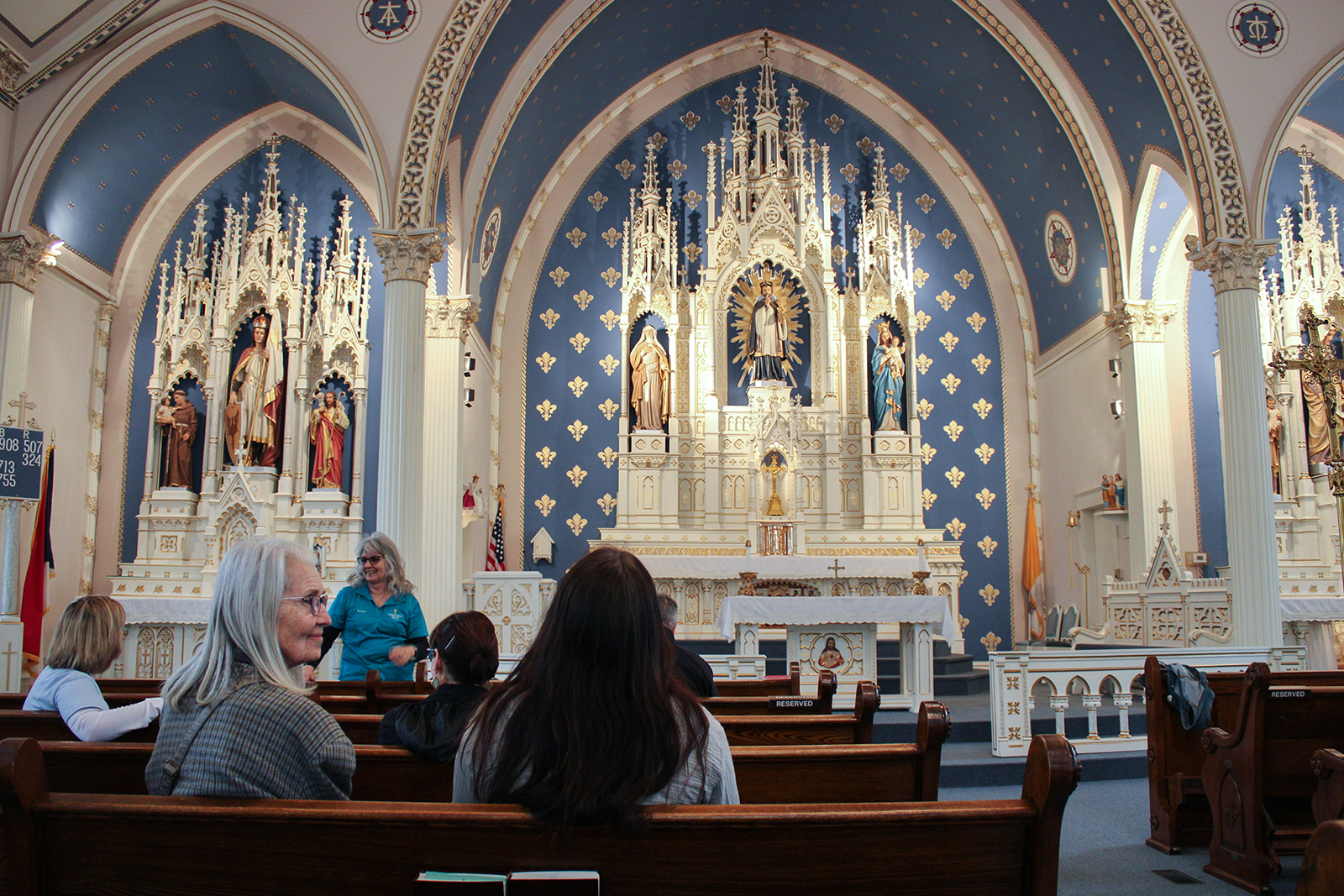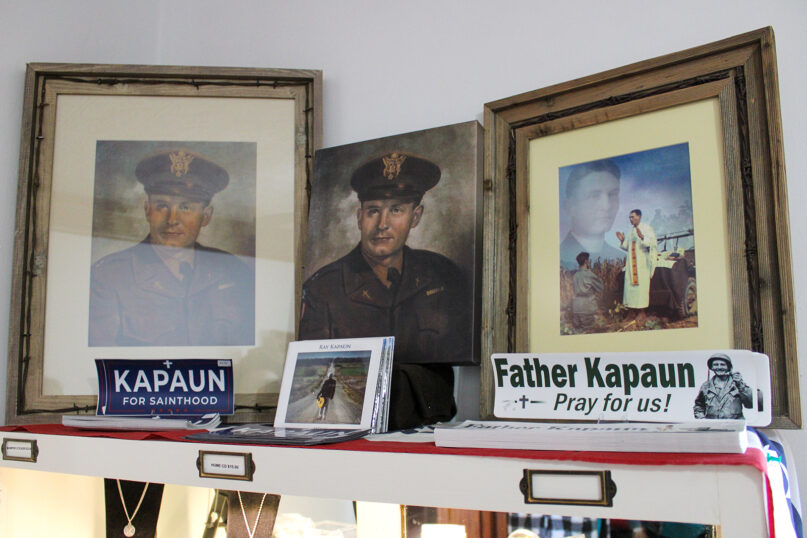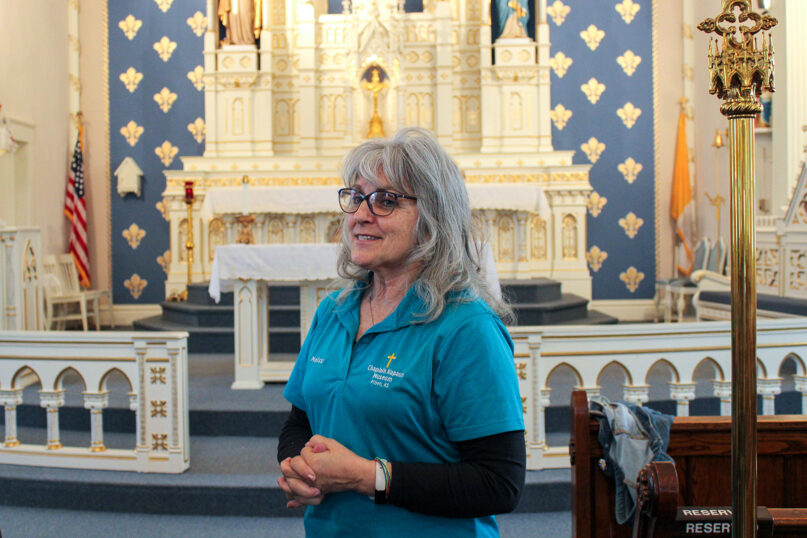
PILSEN, Kan. (RNS and NPR) — Nestled between rolling prairies and wind turbines about 60 miles north of Wichita, the rural farming community of Pilsen has no post office, gas station or stoplight. What it does have is the Chaplain Kapaun Museum and St. John Nepomucene Church, which draws a couple hundred visitors here each month — a number that is likely to grow significantly in the coming years.
The visitors come because of the Rev. Emil Kapaun, a Catholic priest and Korean War hero who’s under consideration by the Vatican for sainthood. Earlier this year, Pope Francis named Kapaun “venerable,” bringing him one step closer to canonization. The road ahead is long, but it could bring big changes to his hometown.
On a recent Friday afternoon at Kapaun’s museum — housed in the rectory where he lived as a young priest in the early 1940s — volunteer tour guide Melissa Stuchlik flipped through the museum’s guest book, filled with names from Kansas, Texas, California and beyond. In the church next door, more than a dozen young men gathered for Mass after making a 75-mile pilgrimage on foot in Kapaun’s honor.
Stuchlik says the journey to Pilsen is a spiritual experience for many visitors.
“There’s something special about driving away from the commotion of the city,” she said. “It’s focusing.”
As an Army chaplain in World War II and the Korean War, Kapaun didn’t carry a gun. But President Barack Obama, while awarding him a posthumous Medal of Honor in 2013 for his bravery on the battlefield, said the priest wielded the mightiest weapon of all.
“A love for his brothers so pure,” Obama said, “that he was willing to die so that they might live.”

Items at the Chaplain Kapaun Museum in Pilsen, Kan., on March 21, 2025. (Photo by Rose Conlon/KMUW)
Kapaun dragged injured soldiers to safety during the Battle of Unsan. As enemy forces closed in, he allowed himself to be captured so he could continue to care for his men. In the Korean prison camp where they were held, that meant stealing food and medicine to keep them alive and tending to the sick — just as much as it did offering spiritual guidance to men from a wide range of faiths. Kapaun reportedly prayed not only for his fellow prisoners of war, but also for the guards who held them captive.
After falling ill and being denied medical attention, Kapaun died in the camp in 1951 at the age of 35.
As Stuchlik walked a tour group through the Pilsen church, she pointed out the crucifix Kapaun carried as an altar server and the baptismal font in which he was baptized. Both would become second-class relics if — or as Stuchlik says, when — Kapaun is named a saint. Relics are objects venerated by the church due to their connection with a saint, including physical remains and personal artifacts. They serve as tangible points of connection with the holy.
“We’ve had kids (from) as far as South Korea come to be baptized in our baptismal font,” Stuchlik said.
Visitor numbers have picked up in Pilsen since Kapaun was declared venerable. Stuchlik says adding more tours requires keeping the church open every day, meaning higher air conditioning bills in the hot Kansas summer. But it’s nothing compared to what could happen later — the relics of saints can draw tens of thousands of pilgrims to holy places each year. That could mean big changes for Pilsen.

Melissa Stuchlik leads a tour of St. John Nepomucene Church, March 21, 2025, in Pilsen, Kan. (Photo by Rose Conlon/KMUW)
“I think it would be a lot of bed and breakfasts popping up all over the place,” Stuchlik said. “We joke about the McDonald’s and the Hyatt.”
She says there’s a lot for the town to gain — and maybe lose.
“Because right now, if you sat outside on our front porch, you would hear the quiet and the peacefulness. And we’d want to keep some of that.
“But,” she added, “there will always be a place in Pilsen for Father.”
The Vatican declared Kapaun a Servant of God in 1993, beginning a formal investigation into his cause for sainthood. But his cause began to look rosier in 2021 when his remains — thought to be lost in a mass grave in Korea — were identified in an unmarked grave in Hawaii. His body now lies in the Cathedral of the Immaculate Conception in Wichita.
The next step on the path to sainthood is beatification, which could jump-start an effort to build a shrine to Kapaun.
“Beatification is really the step where things start to change,” said Scott Carter, coordinator for Kapaun’s cause for sainthood. “I think there’s a great desire to have a shrine to Kapaun.”

Pilsen, red marker, is in central Kansas. (Image courtesy of Google Maps)
Shrines, which are often churches, house relics and artifacts of those venerated by the church. They serve as pilgrimage sites — sacred destinations for Catholics seeking to deepen their connection with their faith through a physical journey.
It’s not clear yet whether Kapaun’s would be in Pilsen, about 3 miles northeast of the farm where he grew up, or elsewhere in the diocese, such as Wichita.
Two hours south, the Archdiocese of Oklahoma City wrestled with a similar question after the Vatican beatified Oklahoma martyr and priest Stanley Rother in 2017.
The shrine’s executive director, Miguel Mireles, said leaders determined Rother’s small Oklahoma hometown of Okarche wouldn’t have been able to support the number of visitors the shrine would draw.
“Part of the deal with building a shrine is that you have pilgrims coming on pilgrimage from all over, and you have to have amenities for them,” he said. “They need a place to stay, they need a place to eat.”
Rother’s shrine was built in Oklahoma City and opened to the public in 2023. Last year, around a quarter million people visited.

The Chaplain Kapaun Museum in Pilsen, Kan., is in the former rectory where the Rev. Emil Kapaun once lived. (Photo by Rose Conlon/KMUW)
“Now, there’s more folks that are looking at investing in (hospitality) businesses around us because there’s more demand.”
Mireles says the shrine brought a new, large-capacity church to Oklahoma City’s substantially Hispanic south side, which was struggling with overcrowding in its existing churches. And it served as a new anchor to the city’s growing Catholic community.
“It’s an exciting time to see the church alive, here in our home,” he said.
But sainthood — and a busier Pilsen — could be decades away. The Vatican will next investigate potential miracles attributed to Kapaun’s intercession from heaven. Catholics believe saints can bring prayers to God on their behalf. One confirmed miracle is needed for beatification and a second is needed for canonization as a saint.
“Most of the time, these are medical miracles,” said Scott Carter, the coordinator for Kapaun’s cause for sainthood at the Catholic Diocese of Wichita. “Because we’re able to look for evidence of an actual problem, to show that there’s a change that happens and that change can’t be explained through medical intervention.”

The Rev. Emil Kapaun celebrates Mass, using the hood of his jeep as an altar, as his assistant, Patrick J. Schuler, kneels in prayer in Korea on Oct. 7, 1950, less than a month before Kapaun was taken prisoner. (Photo by U.S. Army Col. Raymond A. Skeehan/Creative Commons)
Saints and stories of their miracles perform two key functions in the church, according to Carter. They serve as examples for Catholics on how to live the gospel in today’s age. And they offer solace during times of hardship.
“It reminds us,” he said, “that God has not left us alone.”
One potential miracle attributed to Kapaun involves Chase Kear, a former college athlete who nearly died in a pole-vaulting accident in 2008. Sitting in his parent’s living room in Colwich, Kansas, the memory of the fateful track practice still brings him to tears.
He was 14 feet in the air when, he says, he realized he’d lost control. He flew past the landing mat and landed head-first on the hard track, fracturing his skull from ear to ear.
“All I remember was a white flash,” he said.
After being airlifted to the hospital, Chase was put into a medically induced coma. But it didn’t stop his brain from swelling. Doctors told his mom, Paula, that they’d have to remove part of his skull.
“They told us that he has a better chance of dying on the table than living through the surgery,” she said.

Paul Kear, from left, Paula Kear, Stephanie Dalton-Kear and Chase Kear in Colwich, Kan., on March 30, 2025. (Photo by Rose Conlon/KMUW)
Chase did live through the surgery. And, despite doctors removing around 10% of his brain, he started walking, then talking. He graduated college and got a job; got married and had kids. Paula says he’s defied every doctor’s expectations.
“They cannot explain it,” she said. “And they, every one of them, have said that he is a miracle.”
Through it all, his family and church community prayed. One constant they repeated was the Father Kapaun Prayer, asking him to intercede for Chase’s healing.
Stuchlik thinks Kapaun’s work has continued in the years since his death. Many who live in Pilsen and many who visit have stories of their own.
“They know that Father has touched their lives,” she said. “And we know he touches ours.”

A stone marker in Pilsen, Kan., highlights it as the home of Chaplain Kapaun. (Photo by Rose Conlon/KMUW)
Regardless of what happens next with Kapaun’s cause for sainthood, Stuchlik is excited for his story to continue to spread — and for what it could mean for her community. Including, she says, for its potholes.
“Hopefully, as we get more traffic into Pilsen, we’ll be more of a priority,” she said. “It’d be great if we could get the roads a little less bumpy.”
A broadcast version of this story originally aired on NPR and appears here through a partnership between NPR and RNS.
